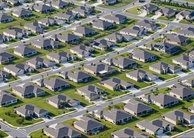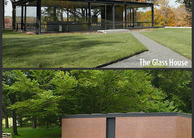Opinion:A Preservationist's Perspective on Levittown Communities: Urban Planning and Design's Awkward Dilemma
By
2012, Vol. 4 No. 01 | pg. 1/2 | » Suburban housing is the backbone of an unsustainable living pattern. Long commutes to work and long drives for groceries, other supplies, and recreational activities increase America’s need for expensive fossil fuels. The isolated nature of subdivision style housing also decreases opportunity for interpersonal communication, which lessens the community experience and overall quality of life in a city. Modern smart growth principles, a dominant trend in planning theory and urban design, aim to concentrate housing as well as amenities closer to city centers. Smart growth advocates therefore condemn suburban subdivisions for their inefficiency and would like to see a switch to multiunit mixed-use housing. One core tenant of smart growth will soon cause friction in the planning community. Historic preservation is vital to sustainability because it allows for new uses of existing structures, minimizing waste of materials. Preservation principles apply, in theory, to any structure that meets a list of basic criteria, even suburban subdivision houses. The next decade or two will see a clash of beliefs among preservationists and smart growth advocates, and will determine whether the preservation community will view aging rows of ranch houses worthy of preserving and restoring. I argue that these aging buildings are worthy of conservation, but in a limited, reasonable way. Americans created a hodge-podge of unsustainable, sprawling housing through a series of unhappy accidents. A perfect storm of socioeconomic events and government policy created a demand for affordable housing large enough for one family but small enough that the average American could buy both a house and the surrounding lot. In the years after World War II, a booming American economy, combined with individuals’ desire for property ownership, created high demand for new houses. City centers were still teeming with commerce and industry, making it difficult to find house-sized plots close to the workplaces of the growing middle class.1 Developers responded to the new type of demand by building millions of single-family dwellings on land in urban peripheries that had been farmland in the years before the war. Residents in the new neighborhoods depended completely on automobile transportation to get to work, school, and to shop. The buildings were architecturally simple. They were functional only as dwelling units. Throughout the rest of the twentieth and into the twenty-first centuries, the post-war precedent for housing remained the dominant form of residential construction. The results have been an increase in American dependency on fossil fuels, unnecessary and redundant use of building materials, and a decrease in the social aspects of American cities.The post war years—approximately 1946 through the late 1960s—saw two different “booms” in the United States. First, an economic boom triggered by pre-war New Deal legislation and wartime manufacturing, and second, a population boom triggered by optimism from military victory and the aforementioned economic tide. The federal government put policies in place to take advantage of individual families’ desire for higher standards of living, higher wages, and the nation’s growing population. The United States’ victory over Japan in 1945 meant approximately sixteen million soldiers returning home. Two different Congressional creations allowed most of those troops to purchase homes. A pre-war piece of New Deal legislation, the National Housing Act of 1934, created the Federal Housing Administration (FHA) to underwrite purchases and/or construction of homes. Towards the end of the war, Congress also passed the Servicemen’s Readjustment Act of 1944, which established a low-interest, low down payment mortgage program available only to military veterans (commonly called “VA loans”). Those two pieces of legislation put the finances in place for construction of “Levittown” style communities all over the United States. Developer Abraham Levitt and his family firm Levitt & Sons revolutionized housing construction2 in the United States by creating the blueprint for twentieth century suburban homebuilding. The Levitts benefitted from two circumstances that both put them in a position to build thousands of suburban homes very quickly and inspired the exact sort of housing the returning troops desired. Levitt & Sons operated in an area of the country—New York and eastern Pennsylvania—with a high population and a proportionately high number of military draftees and volunteers. As the cities of New York and Philadelphia grew, residents collectively desired a lifestyle centered somewhere else besides crowded and dirty downtown areas. Meanwhile, the farmland around the Levitts’ hometown of Island Trees, New York relied heavily on potatoes, and a recent large-scale infestation of a deadly pathogen crippled the wartime crop. Thousands of acres of decimated farmland were available cheap for rezoning and residential construction.3 Abraham Levitt’s son William served in the U.S. Navy during the war and worked on construction projects for military housing on and near naval bases. The Navy taught him utilitarian construction principles. By the 1940s, the military ascribed to the “form fits function” mentality, meaning that construction of dwellings should be done in the cheapest way and allow only for the features literally necessary for a home. William Levitt brought this efficiency-minded approach home to his father’s company after the war. He convinced his father that building relatively small houses on small plots on the newly devalued farmland would be affordable on a large scale and meet the housing demand created by the socioeconomic conditions of post-war urban areas. The Levitts found more demand than they could initially meet. They sold houses before they were built, as William Levitt’s insights proved even more profitable than he had hoped. To their credit, the original subdivisions were much more walkable than what we normally call “Levittowns” today. They included community amenities and did not rely as heavily on automobile transportation. However, the advent of the interstate system and increasing car ownership among the middle classes allowed for housing several miles from workplaces. Also, suburban municipalities enacted Euclidian zoning codes, making it difficult for developers to locate different use structures in close proximity. So just as the perfect storm of socioeconomic events and public policy created an unprecedented housing market, a perfect storm of affordable cars, interconnected highways, and zoning codes turned “Levittown” style communities into subdivisions made up of nothing but houses. Due to the ease of utilitarian building and the profitability of house-only neighborhoods, a bastardized form of Levitt’s original work spread across the nation and is still the archetype for new housing today. Recent trends in planning theory and practice center around Smart Growth—a movement to use urban land in the most efficient and sustainable way possible. The core principles of Smart Growth are, inter alia: “mix land uses . . . create a range of housing opportunities and choices; create walkable neighborhoods; strengthen and direct development towards existing communities; [and] provide a variety of transportation choices.” 4 Incorporation of those principles into urban and suburban growth should curtail the negative side effects of urban sprawl. Smart growth advocates struggle with developers who are set in their ways and wish to continue building in the auto-dependant sprawl patterns of the post-World War II boom, residents who are unwilling to rely less on their automobiles, local governments that hold tight to Euclidian zoning practices, and courts unwilling to infringe on the perceived rights of property owners. One tenet of smart growth, historic preservation, promotes the reuse or continued use of existing buildings. Preservationists, empowered by federal, state, and local government guidelines, seek to prevent the unnecessary destruction of all different manners of buildings in order to preserve the nation’s heritage. Often times, the roll of a preservationist is to prevent private action to demolish historic structures for new development. Preservation plays directly into smart growth because the continual use of buildings and the materials therein is a sustainable way to treat natural resources.Continued on Next Page » Suggested Reading from Inquiries Journal
Inquiries Journal provides undergraduate and graduate students around the world a platform for the wide dissemination of academic work over a range of core disciplines. Representing the work of students from hundreds of institutions around the globe, Inquiries Journal's large database of academic articles is completely free. Learn more | Blog | Submit Latest in Architecture |















